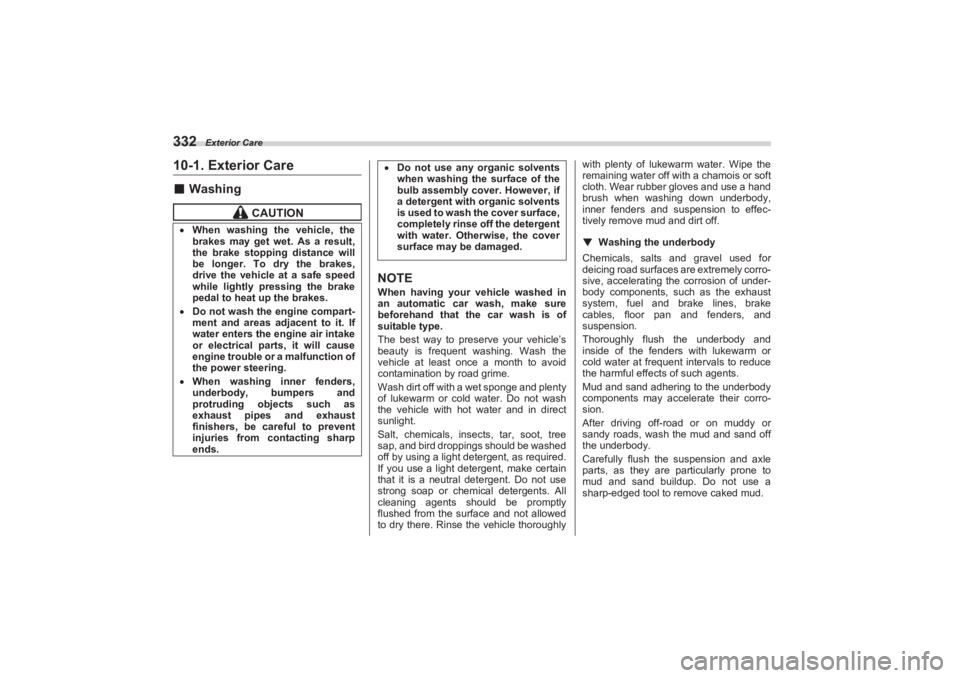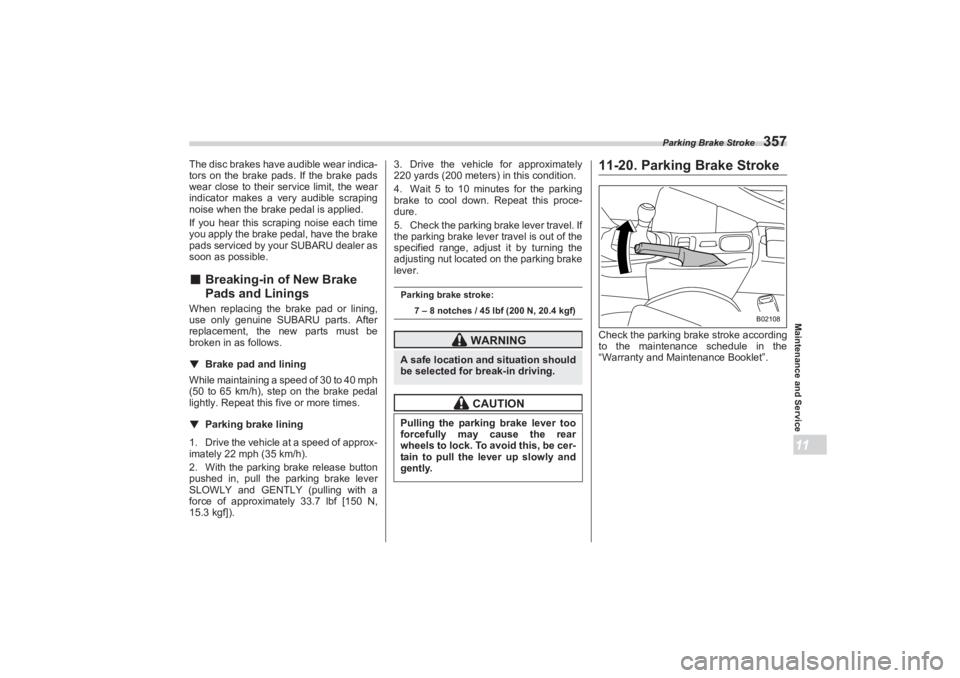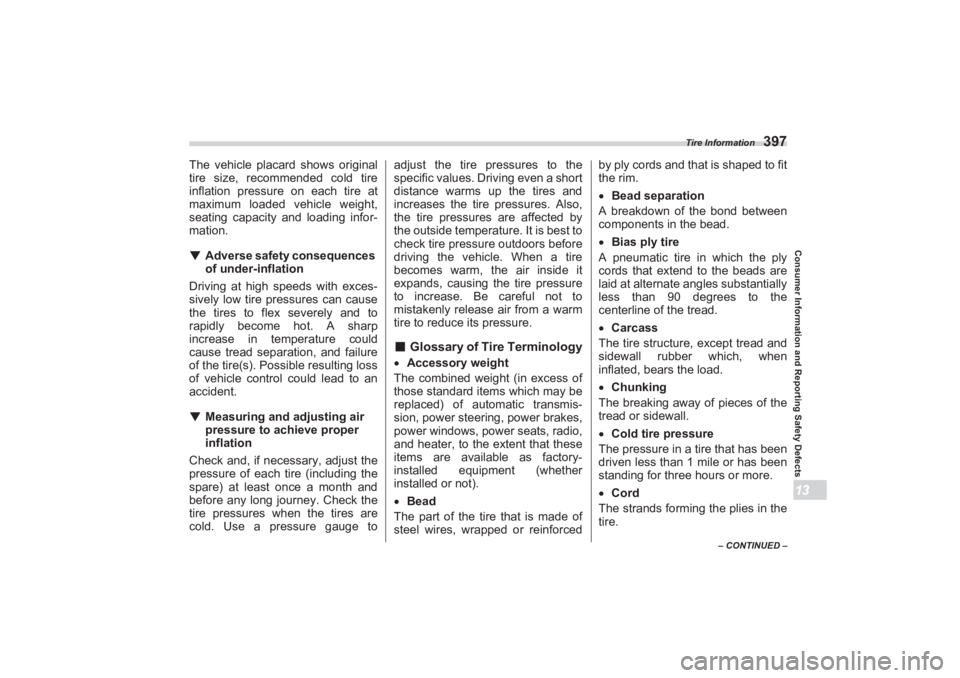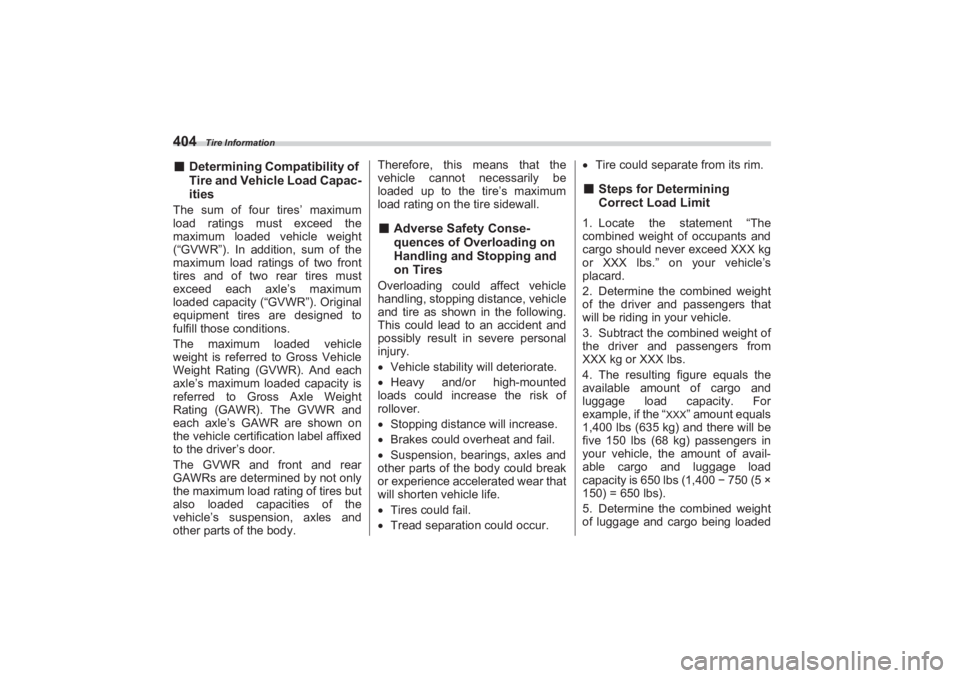2023 SUBARU BRZ brakes
[x] Cancel search: brakesPage 338 of 432

Exterior Care
33210-1. Exterior Care■Washing
NOTE
When having your vehicle washed in
an automatic car wash, make sure
beforehand that the car wash is of
suitable type.
The best way to preserve your vehicle’s
beauty is frequent washing. Wash the
vehicle at least once a month to avoid
contamination by road grime.
Wash dirt off with a wet sponge and plenty
of lukewarm or cold water. Do not wash
the vehicle with hot water and in direct
sunlight.
Salt, chemicals, insects, tar, soot, tree
sap, and bird droppings should be washed
off by using a light detergent, as required.
If you use a light detergent, make certain
that it is a neutral detergent. Do not use
strong soap or chemical detergents. All
cleaning agents should be promptly
flushed from the surface and not allowed
to dry there. Rinse the vehicle thoroughly with plenty of lukewarm water. Wipe the
remaining water off with a chamois or soft
cloth. Wear rubber gloves and use a hand
brush when washing down underbody,
inner fenders and suspension to effec-
tively remove mud and dirt off.
▼ Washing the underbody
Chemicals, salts and gravel used for
deicing road surfaces are extremely corro-
sive, accelerating the corrosion of under-
body components, such as the exhaust
system, fuel and brake lines, brake
cables, floor pan and fenders, and
suspension.
Thoroughly flush the underbody and
inside of the fenders with lukewarm or
cold water at frequent intervals to reduce
the harmful effects of such agents.
Mud and sand adhering to the underbody
components may accelerate their corro-
sion.
After driving off-road or on muddy or
sandy roads, wash the mud and sand off
the underbody.
Carefully flush the suspension and axle
parts, as they are particularly prone to
mud and sand buildup. Do not use a
sharp-edged tool to remove caked mud.
CAUTION
When washing the vehicle, the
brakes may get wet. As a result,
the brake stopping distance will
be longer. To dry the brakes,
drive the vehicle at a safe speed
while lightly pressing the brake
pedal to heat up the brakes. Do not wash the engine compart-
ment and areas adjacent to it. If
water enters the engine air intake
or electrical parts, it will cause
engine trouble or a malfunction of
the power steering. When washing inner fenders,
underbody, bumpers and
protruding objects such as
exhaust pipes and exhaust
finishers, be careful to prevent
injuries from contacting sharp
ends.
Do not use any organic solvents
when washing the surface of the
bulb assembly cover. However, if
a detergent with organic solvents
is used to wash the cover surface,
completely rinse off the detergent
with water. Otherwise, the cover
surface may be damaged.
BRZ_U.book 332 ページ 2022年3月29日 火曜日 午後3時59分
Page 363 of 432

Parking Brake Stroke
357
Maintenance and Service11
The disc brakes have audible wear indica-
tors on the brake pads. If the brake pads
wear close to their service limit, the wear
indicator makes a very audible scraping
noise when the brake pedal is applied.
If you hear this scraping noise each time
you apply the brake pedal, have the brake
pads serviced by your SUBARU dealer as
soon as possible.■ Breaking-in of New Brake
Pad s and LiningsWhen replacing the brake pad or lining,
use only genuine SUBARU parts. After
replacement, the new parts must be
broken in as follows.
▼ Brake pad and lining
While maintaining a speed of 30 to 40 mph
(5 0 to 65 km/h), step on the brake pedal
lightly. Repeat this five or more times.
▼ Parking brake lining1. Drive the vehicle at a speed of approx-
imately 22 mph (35 km/h).
2. With the parking brake release button
pushed in, pull the parking brake lever
SLOWLY and GENTLY (pulling with a
force of approximately 33.7 lbf [150 N,
15.3 kgf]). 3. Drive the vehicle for approximately
220 yards (200 meters) in this condition.
4. Wait 5 to 10 minutes for the parking
brake to cool down. Repeat this proce-
dure.
5. Check the parking brake lever travel. If
the parking brake lever travel is out of the
specified range, adjust it by turning the
adjusting nut located on the parking brake
lever.
11-20. Parking Brake StrokeCheck the parking brak e stroke according
to the maintenance schedule in the
“Warranty and Maintenance Booklet”.
Parking brake stroke:
7 – 8 notches / 45 lbf (200 N, 20.4 kgf)
WARNING
A safe location and situation should
be selected for break-in driving.
CAUTION
Pulling the parking brake lever too
forcefully may cause the rear
wheels to lock. To avoid this, be cer-
tain to pull the lever up slowly and
gently.
B02108
BRZ_U.book 357 ページ 2022年3月29日 火曜日 午後3時59分
Page 403 of 432

Tire Information
397
Consumer Information and Reporting Safety Defects13
– CONTINUED –
The vehicle placard shows original
tire size, recommended cold tire
inflation pressure on each tire at
maximum loaded vehicle weight,
seating capacity and loading infor-
mation.▼ Adverse safety consequences
of under-inflation
Driving at high speeds with exces-
sively low tire pressures can cause
the tires to flex severely and to
rapidly become hot. A sharp
increase in temperature could
cause tread separation, and failure
of the tire(s). Possible resulting loss
of vehicle control could lead to an
accident.
▼ Measuring and adjusting air
pressure to achieve proper
inflation
Check and, if necessary, adjust the
pressure of each tire (including the
spare) at least once a month and
before any long journey. Check the
tire pressures when the tires are
cold. Use a pressure gauge to adjust the tire pressures to the
specific values. Driving even a short
distance warms up the tires and
increases the tire pressures. Also,
the tire pressures are affected by
the outside temperature. It is best to
check tire pressure outdoors before
driving the vehicle. When a tire
becomes warm, t he air inside it
expands, causing the tire pressure
to increase. Be careful not to
mistakenly release air from a warm
tire to reduce its pressure.
■ Glossary of Tire TerminologyAccessory weight
The combined weight (in excess of
those standard items which may be
replaced) of automatic transmis-
sion, power steering, power brakes,
power windows, power seats, radio,
and heater, to the extent that these
items are available as factory-
installed equipment (whether
installed or not).
Bead
The part of the tire that is made of
steel wires, wrapped or reinforced by ply cords and that is shaped to fit
the rim.
Bead separation
A breakdown of the bond between
components in the bead.
Bias ply tire
A pneumatic tire in which the ply
cords that extend to the beads are
laid at alternate an gles substantially
less than 90 degrees to the
centerline of the tread.
Carcass
The tire structure, except tread and
sidewall rubber which, when
inflated, bears the load.
Chunking
The breaking away of pieces of the
tread or sidewall.
Cold tire pressure
The pressure in a tire that has been
driven less than 1 mile or has been
standing for three hours or more.
Cord
The strands forming the plies in the
tire.
BRZ_U.book 397 ページ 2022年3月29日 火曜日 午後3時59分
Page 405 of 432

Tire Information
399
Consumer Information and Reporting Safety Defects13
– CONTINUED –
Occupant distribution
Distribution of occupants in a
vehicle as specified in the third
column of Table 1 that is appended
to the end of this section.
Open splice
Any parting at any junction of tread,
sidewall, or innerliner that extends
to cord material.
Outer diameter
The overall diameter of an inflated
new tire.
Overall width
The linear distance between the
exteriors of the sidewalls of an
inflated tire, including elevations
due to labeling, decorations, or
protective bands or ribs.
Passenger car tire
A tire intended for use on passenger
cars, multipurpose passenger vehi-
cles, and trucks, that have a gross
vehicle weight rating (GVWR) of
10,000 lbs (4,535 kg) or less.
Ply
A layer of rubber-coated parallel
cords.
Ply separation
A parting of rubber compound
between adjacent plies.
Pneumatic tire
A mechanical device made of
rubber, chemicals, fabric and steel
or other materials, that, when
mounted on an automotive wheel,
provides the traction and contains
the gas or fluid that sustains the
load.
Production options weight
The combined weight of those
installed regular production options
weighing over 5.1 lbs (2.3 kg) in
excess of those standard items
which they replace, not previously
considered in curb weight or acces-
sory weight, including heavy duty
brakes, ride levelers, roof rack,
heavy duty battery, and special trim.
Radial ply tire
A pneumatic tire in which the ply
cords that extend to the beads are
laid at substantially 90 degrees to
the centerline of the tread.
Recommended inflation pres-
sure
The cold inflation pressure recom-
mended by a vehicle manufacturer.
Reinforced tire
A tire designed to operate at higher
loads and at higher inflation pres-
sures than the corresponding stan-
dard tire.
Rim
A metal support for a tire or a tire
and tube assembly upon which the
tire beads are seated.
Rim diameter
Nominal diameter of the bead seat.
Rim size designation
Rim diameter and width.
BRZ_U.book 399 ページ 2022年3月29日 火曜日 午後3時59分
Page 410 of 432

Tire Information
404■Determining Compatibility of
Tire and Vehicle Load Capac -
itiesThe sum of four tires’ maximum
load ratings must exceed the
maximum loaded vehicle weight
(“GVWR”). In addition, sum of the
maximum load ratings of two front
tires and of two rear tires must
exceed each axle’s maximum
loaded capacity (“GVWR”). Original
equipment tires are designed to
fulfill those conditions.
The maximum loaded vehicle
weight is referred to Gross Vehicle
Weight Rating (GVWR). And each
axle’s maximum loaded capacity is
referred to Gross Axle Weight
Rating (GAWR). The GVWR and
each axle’s GAWR are shown on
the vehicle certific ation label affixed
to the driver’s door.
The GVWR and front and rear
GAWRs are determined by not only
the maximum load rating of tires but
also loaded capacities of the
vehicle’s suspension, axles and
other parts of the body. Therefore, this means that the
vehicle cannot necessarily be
loaded up to the tire’s maximum
load rating on the tire sidewall.
■ Adverse Safety Conse -
quences of Overloading on
Handling and Stopping and
on TiresOverloading could affect vehicle
handling, stopping distance, vehicle
and tire as shown in the following.
This could lead to an accident and
possibly result in severe personal
injury.
Vehicle stability will deteriorate.
Heavy and/or high-mounted
loads could increase the risk of
rollover.
Stopping distance will increase.
Brakes could overheat and fail.
Suspension, bearings, axles and
other parts of the body could break
or experience accelerated wear that
will shorten vehicle life.
Tires could fail.
Tread separation could occur.
Tire could separate from its rim.
■ Steps for Determining
Correct Load Limit1. Locate the statement “The
combined weight of occupants and
cargo should never exceed XXX kg
or XXX lbs.” on your vehicle’s
placard.
2. Determine the combined weight
of the driver and passengers that
will be riding in your vehicle.
3. Subtract the combined weight of
the driver and passengers from
XXX kg or XXX lbs.
4. The resulting figure equals the
available amount of cargo and
luggage load capacity. For
example, if the “
XXX
” amount equals
1,400 lbs (635 kg) and there will be
five 150 lbs (68 kg) passengers in
your vehicle, the amount of avail-
able cargo and luggage load
capacity is 650 lbs (1,400 − 750 (5 ×
150) = 650 lbs).
5. Determine the combined weight
of luggage and cargo being loaded
BRZ_U.book 404 ページ 2022年3月29日 火曜日 午後3時59分